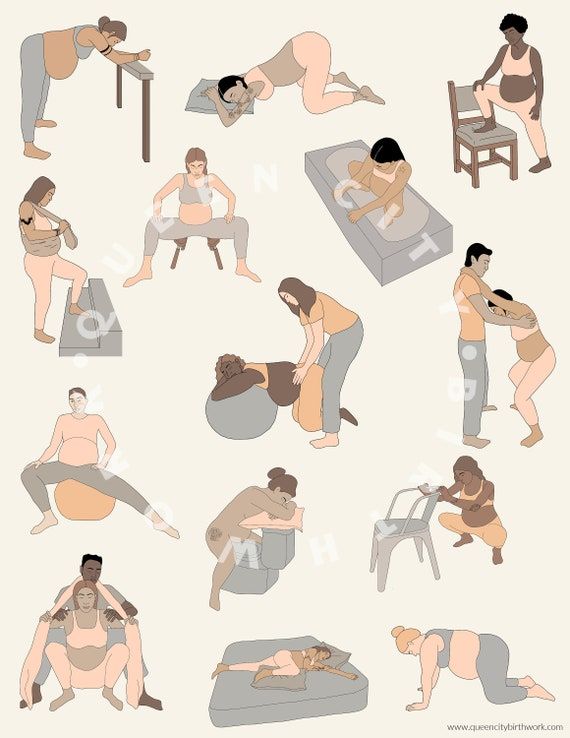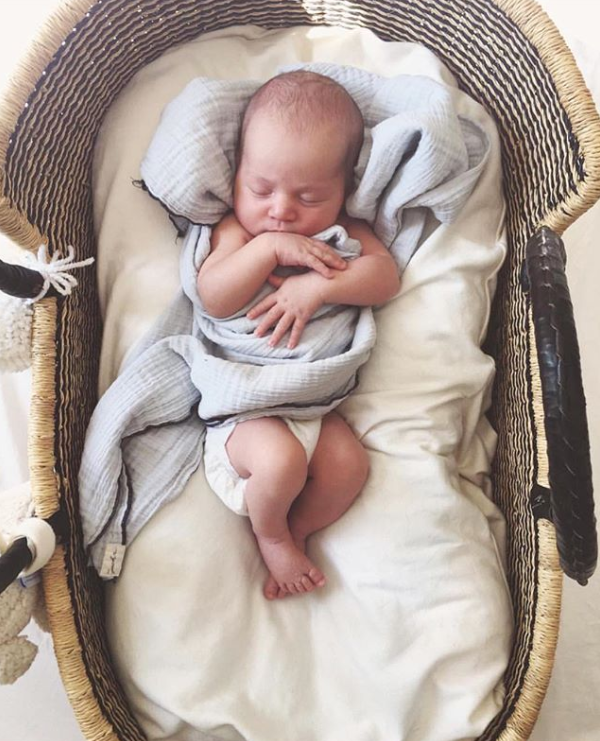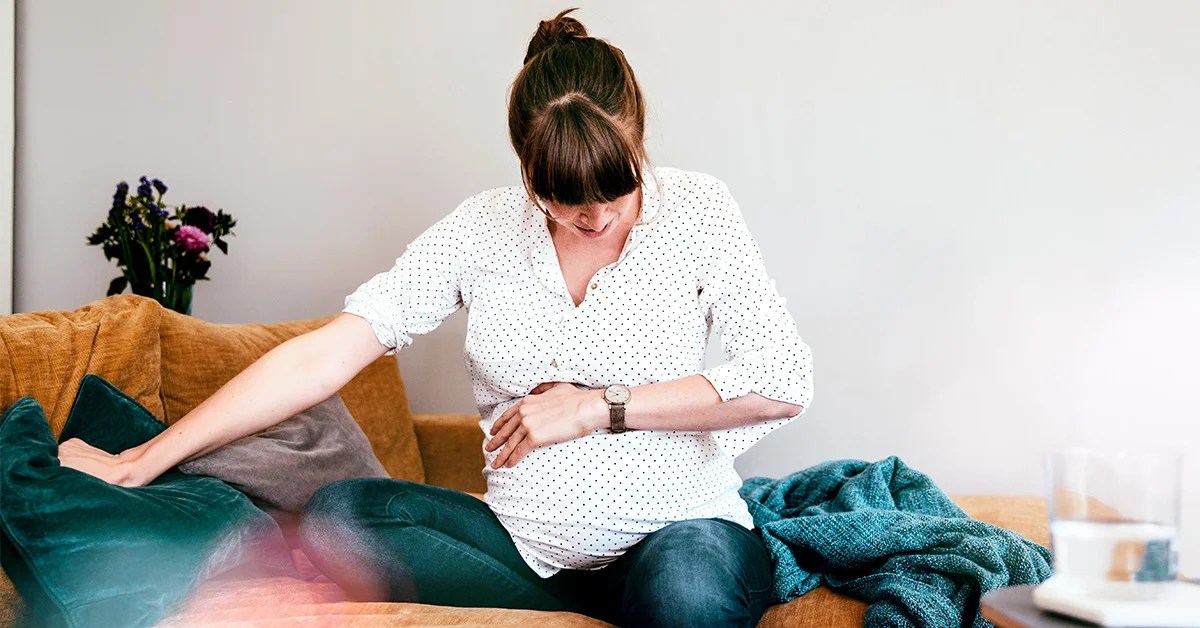Positions for labor and birth
13 Best Labor and Birthing Positions
For nine months you prep and plan for baby’s arrival. You read books, watch videos and maybe even take a birthing class or two. But while movies and TV shows have led many of us to believe both labor and delivery happen while lying on your back with your legs spread wide, anyone who’s been through the experience will tell you it doesn’t have to play out that way.
There are actually a variety of labor positions you can assume during the first phases of childbirth and a whole other set that makes for good birthing positions when it’s time to push—and they don’t all call for you to be flat on your back. “Rotating between different labor and birthing positions is important to optimize conditions for the mom and baby,” says Sara Twogood, MD, an obstetrician gynecologist at Cedars Sinai Medical Center in Los Angeles and author of Ladypartsblog.com. “For Mom, this could mean making her more comfortable, especially if she’s having a medication-free birth. It can also mean maximizing the space in her pelvis so baby has more room.”
Here’s a primer on some of the best labor and birthing positions to help you prepare for the big day.
In this article:
Best labor positions
Best birthing positions
Best Labor Positions
The process of giving birth takes work (it’s not called “labor” for nothing). But that doesn’t mean you shouldn’t find a way to be as comfortable as humanly possible. “Labor positions are used during the labor process to help ease discomfort, move the baby down through the pelvis and encourage optimal fetal positioning,” says Lindsey Bliss, a birth doula and co-director of Carriage House Birth in New York City. “If you end up choosing not to utilize drugs for pain management, labor positions are essential for easing discomfort.”
Active labor, the phase in which contractions come on strong, is often when things really start to hurt. But keep in mind that women don’t start pushing until the cervix is fully dilated—for some women, this happens quickly; for others, not so much.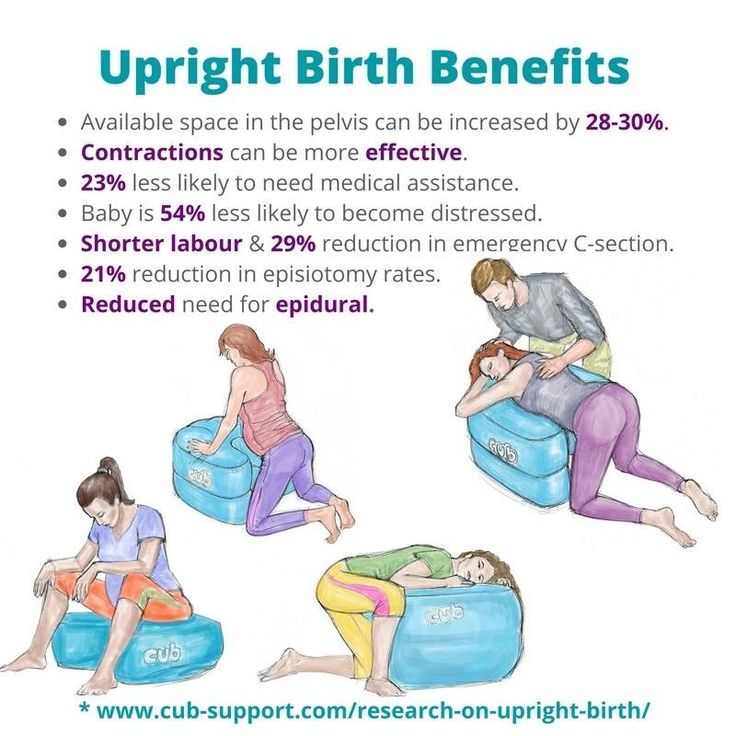 So as your body and baby prepare for delivery, there are several labor positions your doctor or midwife may suggest to get you to the pushing point more comfortably. “Labor and delivery nurses are usually really great at helping a woman move around, even with an epidural, to find the labor positions that feel best for them,” Twogood says. “I recommend women try out a number of positions during labor. Every woman and baby is different, and what works for one woman won’t be ideal for another.”
So as your body and baby prepare for delivery, there are several labor positions your doctor or midwife may suggest to get you to the pushing point more comfortably. “Labor and delivery nurses are usually really great at helping a woman move around, even with an epidural, to find the labor positions that feel best for them,” Twogood says. “I recommend women try out a number of positions during labor. Every woman and baby is different, and what works for one woman won’t be ideal for another.”
Check out some of the most common labor positions:
The hands and knees position
The all fours position calls for you to get down onto your hands and knees, either in bed or on a floor mat. “The hands and knees position is a great one, since it helps open the pelvis,” says Rebekah Wheeler,** RN, CNM, is a certified nurse-midwife in the Bay Area, California. . Adds Megan Cheney, MD, MPH, medical director of the Women’s Institute at Banner University Medical Center in Phoenix, “Sometimes baby’s heart rate responds better when you’re in the hands and knees position, especially if baby isn’t in the best spot.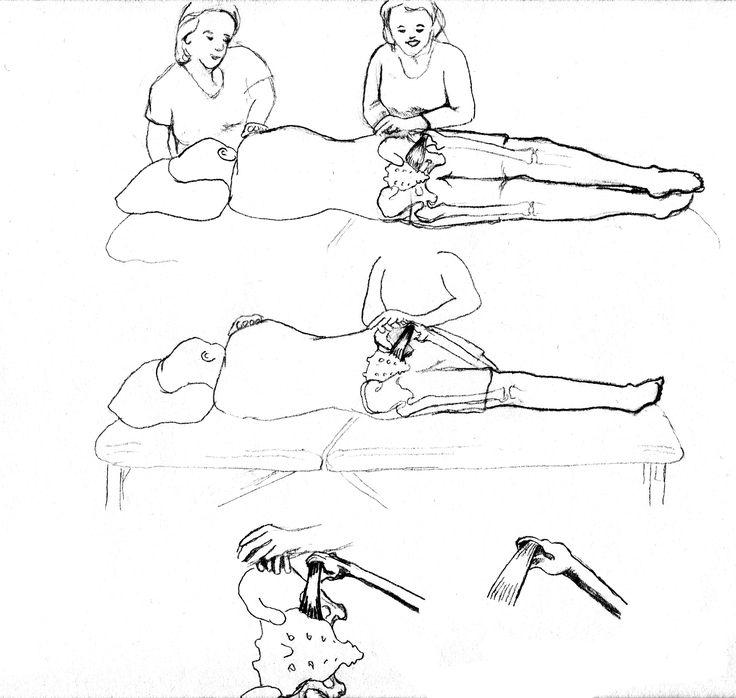 ”
”
Pros:
Cons:
- Your arms may get tired
The sitting position
When you feel baby’s weight bearing down, you may just want to sit down—and that’s okay. Whether it’s in a birthing chair or even on a toilet, sitting and spreading your legs in this labor position can relieve some of the pressure on your pelvis.
Pros:
- Good for resting
- Can still be used with a fetal monitoring machine
- Sitting on a toilet relaxes the perineum, which can help reduce tearing
Cons:
- A hard toilet seat can become uncomfortable
- May not be an option if you’ve had high blood pressure during pregnancy
Birthing ball positions
Besides sitting on a birthing chair or toilet, you can also work the birthing ball into your labor positions. There are more than a few women who hail the prop as their BFF during labor and delivery. “Birthing balls provide support while you shift around,” Twogood says. “Women who want movement in their hips seem to find them helpful.” You can use a birthing ball in several ways: Some women sit or rock on it, lean against it or simply drape their upper bodies over it while kneeling. It can even be used as support while squatting. “I’m a huge fan,” Bliss says. “It’s great because women can continue bouncing and moving through the contractions even while being monitored.” Check beforehand to see if your hospital uses wireless fetal monitors; if not, you’ll be limited in how far you can move in these labor positions.
“Birthing balls provide support while you shift around,” Twogood says. “Women who want movement in their hips seem to find them helpful.” You can use a birthing ball in several ways: Some women sit or rock on it, lean against it or simply drape their upper bodies over it while kneeling. It can even be used as support while squatting. “I’m a huge fan,” Bliss says. “It’s great because women can continue bouncing and moving through the contractions even while being monitored.” Check beforehand to see if your hospital uses wireless fetal monitors; if not, you’ll be limited in how far you can move in these labor positions.
Pros:
-
Can help move baby into a favorable birthing position
-
Relieves back pressure
-
Birthing ball labor positions can help encourage dilation and move baby deeper into the pelvis
Cons:
The squatting position
Squats rarely top anyone’s list of favorite exercises, but on the day you give birth, you may want to give them a try as one of your labor positions. Squatting can be done against a wall or with the support of a chair or partner.
Squatting can be done against a wall or with the support of a chair or partner.
Pros:
Cons:
- May become tiring
The side-lying position
Lying on your side is one of the best labor positions to try when you need a rest. That said, just because you’re lying down doesn’t mean your body is taking a break from labor; on the contrary, it can actually help baby move into the ready position. “Side-lying and using a peanut-shaped birthing ball between the legs are wonderful tools for getting baby to descend and rotate,” Bliss says. “I encourage my clients to flip from side to side during the process to help baby come down and out.”
Pros:
-
Helps get oxygen to baby
-
Can be used if you have high blood pressure
-
Makes it easier to relax during contractions
Cons:
- May be difficult to assess fetal heartbeat
The upright position
Gravity may not be your best friend during pregnancy, but you can make it work to your advantage during childbirth through upright labor positions.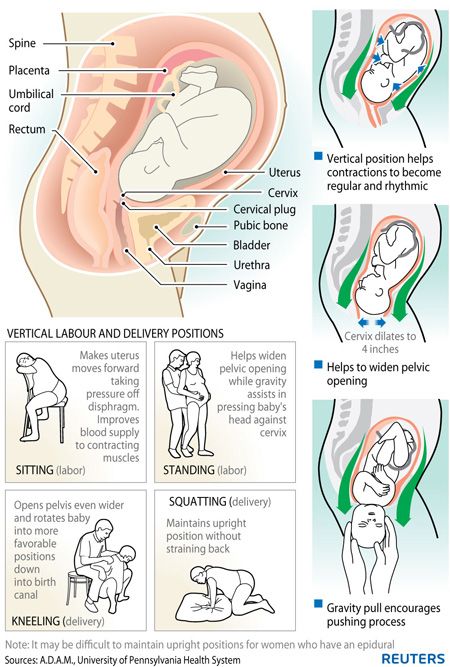 Whether you’re standing, walking or swaying, simply being vertical can get you closer to the finish line. “Walking can be helpful for women who are waiting for labor to progress,” Cheney says. Amy, a mother of two from Connecticut, found that to be the case. “I walked laps around the hospital wing to speed things up,” she says. Swaying while using another person as support is also a good way to work through labor. “Rocking your hips keeps baby moving lower and lower,” Wheeler says. (It’s also good for getting a final hug of support from your partner before the main event!) Here are some other things to consider when it comes to the upright position:
Whether you’re standing, walking or swaying, simply being vertical can get you closer to the finish line. “Walking can be helpful for women who are waiting for labor to progress,” Cheney says. Amy, a mother of two from Connecticut, found that to be the case. “I walked laps around the hospital wing to speed things up,” she says. Swaying while using another person as support is also a good way to work through labor. “Rocking your hips keeps baby moving lower and lower,” Wheeler says. (It’s also good for getting a final hug of support from your partner before the main event!) Here are some other things to consider when it comes to the upright position:
Pros:
Cons:
The lunging position
Doing lunges during labor may not sound like your idea of a good time, but lunging is one of the labor positions you may want to give a whirl. Unlike at the gym, you can put your foot up on a chair for these lunges: Simply lean your body forward onto the raised foot when you feel a contraction coming on.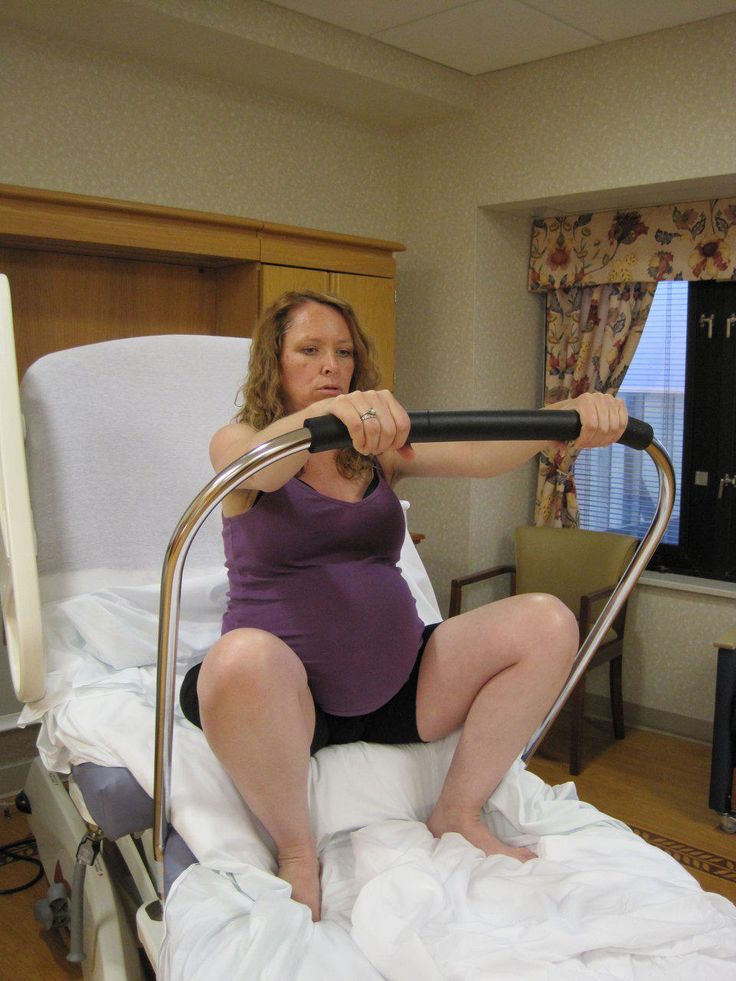 You can repeat it as many times as you want.
You can repeat it as many times as you want.
Pros:
Cons:
- Requires a partner to help you keep your balance
The stair-climbing position
If labor has been progressing nicely and then starts to slow down, baby might need extra encouragement to slip into the optimal position for birth. You may want to consider climbing stairs as one of your labor positions, since it can help baby shift.
Pros:
Cons:
- Can be tiring, especially if you’ve been in labor for a while
Best Birthing Positions
You’ve made it through the first stages of labor—congrats! Now it’s time to switch things up and assume birthing positions for the final stretch. “Birthing positions are used to push baby out,” Bliss says. Like labor positions, birthing positions don’t always equal lying on your back. In fact, “women who are in bed tend to experience more pain than women who move around,” Wheeler says.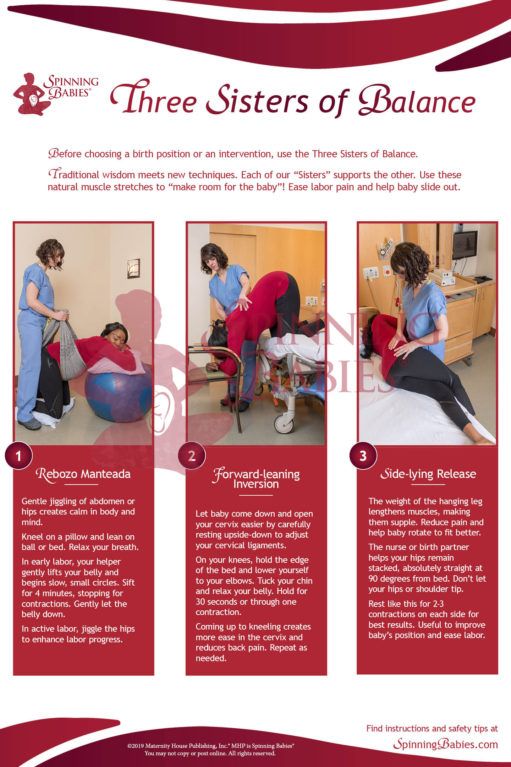 Here are some of the best birthing positions to try.
Here are some of the best birthing positions to try.
Squatting birth positions
Squats aren’t only great to do during labor, but they’re also among the popular birthing positions. Remember, when it comes to labor and delivery, gravity is on your side.
Pros:
Cons:
Reclining birth positions
Childbirth is hard work, and you might need to take a break—which is why many women opt for reclining birthing positions. Keep in mind, “reclining” can mean a number of things—yes, you can lie down in bed, but you can also recline against a wall, a chair or another person.
Pros:
- Can release tension and relax the muscles
- May be a good alternative if a woman is tired but doesn’t want to lie down completely
Cons:
- Can work against gravity
Birthing stool positions
A birthing stool can be used in a variety of birthing positions: Women can squat on it, get in the all fours position and use it to support the arms or even rock back and forth with it, depending on the design of the stool. Bonus: If you like the idea of a water birth, there are some birthing stool models that work in the water.
Bonus: If you like the idea of a water birth, there are some birthing stool models that work in the water.
Pros:
-
Can help baby move farther down
-
Relieves stress on the back
-
Can increase dilation of the cervix
Cons:
- Women may experience increased blood loss
Birthing bar positions
Call it the birthing stool’s cousin: The birthing bar is an attachment that can be added to many labor beds to help support birthing positions. With a birthing bar, you can sit up at any time and squat, leaning on the bar for support. “The birthing bar can be an awesome tool. You can wrap a towel on it to make it easier to use and switch positions,” Wheeler says. That proved to be true for Jennifer, a mom of two from Connecticut, who recalls that “after about two hours of pushing with no success, the birthing bar was put on the bed. It helped me get the resistance I needed to push to the point where the doctor could intervene.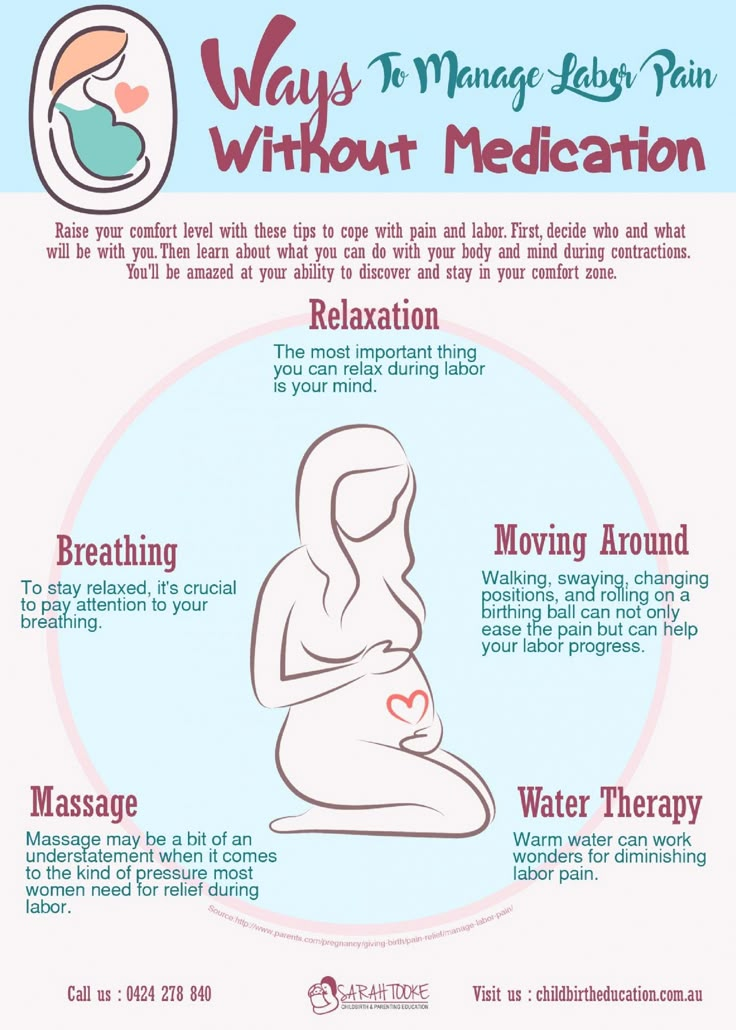 ”
”
Pros:
Cons:
- May not be available at all hospitals
Kneeling birth positions
If baby is facing Mom’s abdomen instead of her back, kneeling can help them turn to get into the proper position. Kneeling is one of the most popular birthing positions because it also gives mom a much-needed break.
Pros:
Cons:
- May be difficult for continuous fetal monitoring
When it comes to labor and birthing positions, discuss all options with your doctor or midwife to land on the ones that will be most comfortable and practical for you. “Every baby and mom responds to positions differently. It’s the job of the labor assistant to help figure out what works best,” Wheeler says. Whichever labor and birthing positions you choose, it’ll all be worth it when baby is finally placed in your arms.
Updated February 2020
Expert bios:
Sara Twogood, MD, FACOG, is a board certified obstetrician-gynecologist at Cedars Sinai Medical Center in Los Angeles.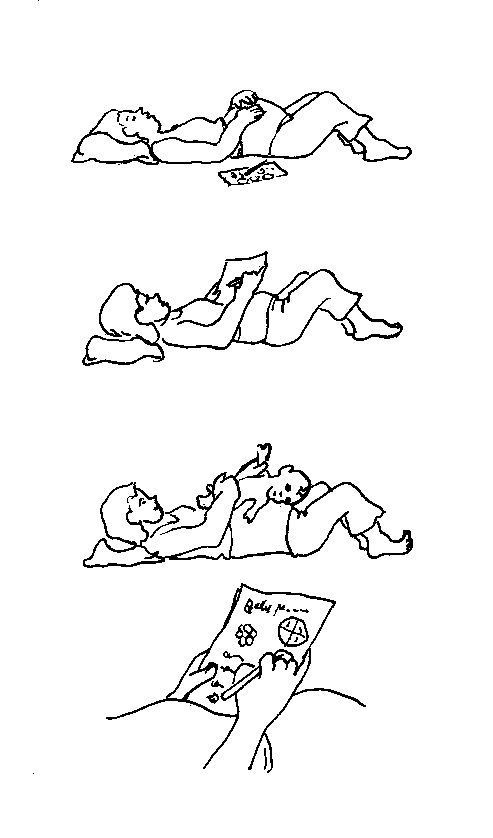 Previously, she held a faculty appointment at USC Keck School of Medicine and practiced general OBGYN in an affiliated private practice. Twogood is also the author of Ladypartsblog.com, which covers topics relating to fertility and pregnancy, and the founder of FemEd, a program designed to empower females through health education.
Previously, she held a faculty appointment at USC Keck School of Medicine and practiced general OBGYN in an affiliated private practice. Twogood is also the author of Ladypartsblog.com, which covers topics relating to fertility and pregnancy, and the founder of FemEd, a program designed to empower females through health education.
Lindsey Bliss is a birth doula and co-founder of Carriage House Birth, a doula agency established in New York City in 2012 that now serves Los Angeles as well.
Rebekah Wheeler, RN, CNM, MPH, is a certified nurse-midwife in the Bay Area, California. She is the founder of the Malawi Women’s Health Collective, a small non-profit organization, and has served on the boards of the California Nurse-Midwifery Association, Planned Parenthood of Rhode Island and the Women’s Health and Education Fund of Southeastern Massachusetts. She holds a Master’s of Public Health and a Master’s of Science in Nursing from Yale University.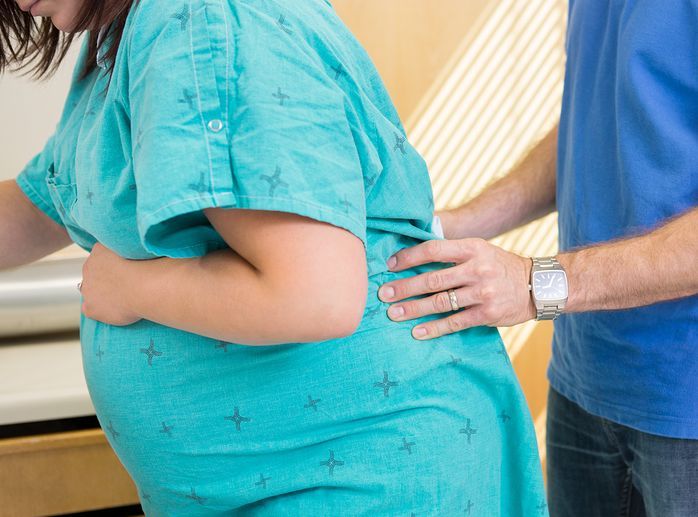
Megan Cheney, MD, MPH, is an ob-gyn and the medical director of the Women’s Institute at Banner University Medical Center in Phoenix, Arizona. She earned her medical degree from University of Arizona College of Medicine in 2009.
Please note: The Bump and the materials and information it contains are not intended to, and do not constitute, medical or other health advice or diagnosis and should not be used as such. You should always consult with a qualified physician or health professional about your specific circumstances.
Plus, more from The Bump:
4 Must-Know Strategies for an Easier Labor and Delivery
5 Medication Options for Pain Relief During Labor
What to Expect During the Different Stages of Labor
Positions for labour and birth
Positions for labour and birth | Pregnancy Birth and Baby beginning of content5-minute read
Listen
There's no rule to say you must give birth flat on your back in a hospital bed.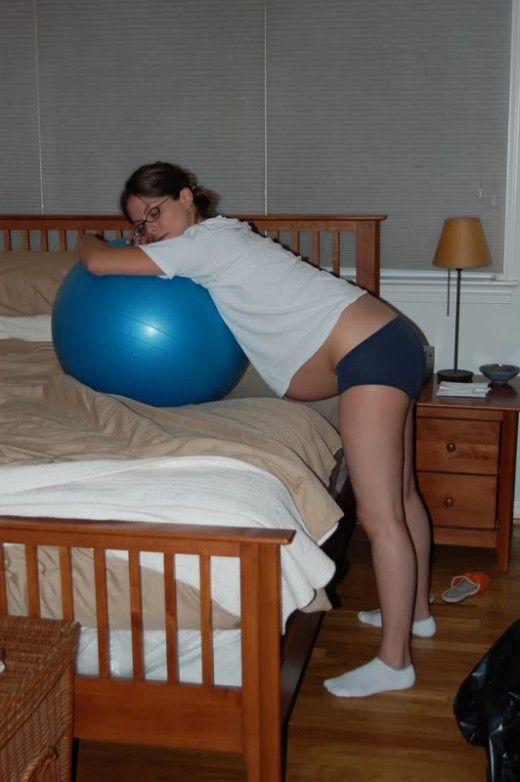 You can choose to move around and into different positions throughout your baby's birth. It's your prerogative. Birthing positions can help you to feel in control, reduce pain and open your pelvis to help the baby come out.
You can choose to move around and into different positions throughout your baby's birth. It's your prerogative. Birthing positions can help you to feel in control, reduce pain and open your pelvis to help the baby come out.
Which position is best?
In the past 100 years, women in Western countries have usually given birth lying down, mostly on their backs. However, in previous centuries they gave birth in an upright position, as women in many other cultures have traditionally done.
Today, you can choose the position that makes you most comfortable, unless there is a medical reason not to. Many women find positions instinctively during labour and birth. You may also choose to practise some of them before you have your baby.
It is recommended that you walk, move and change positions frequently during the various stages of labour.
Positions for stage 1 labour
Early labour
During the first stage, your cervix gets thinner and dilates (opens up) to about 3cm.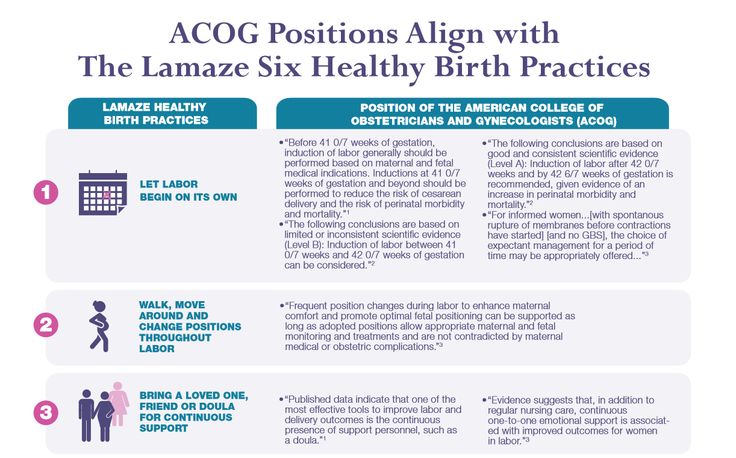 You may still be at home and choose to stand in the shower, sit in the bath, walk around or find another position that's comfortable for you.
You may still be at home and choose to stand in the shower, sit in the bath, walk around or find another position that's comfortable for you.
Unless there is a medical reason to do it, lying on your back is not recommended in the first stage of labour because it can reduce blood supply to your baby and potentially lead to a longer labour. You can, however, rest during this early phase to conserve energy, which you'll need later. Choose a comfy position lying on your side or sitting with your feet up.
Keep moving and changing positions to prevent fatigue and ensure your muscles don't get too sore. You may find yourself standing upright or bent over while rocking and swaying, sometimes called the 'dance of labour'. This can help both you and the baby by easing pressure on the pelvic area and encouraging the baby to move into the correct position in the pelvis.
Active labour
As you move into established, also known as 'active' labour, your cervix dilates from 3 to 10 cm and contractions become more frequent and stronger.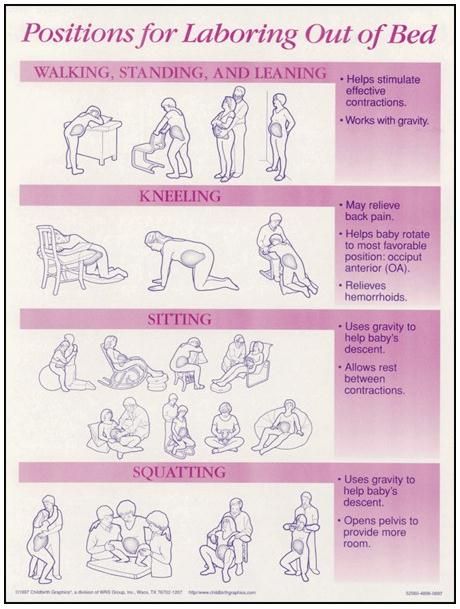
Your maternity team will encourage you to choose your own positions during this phase and may make suggestions to help you. Try to choose an upright position since it has many benefits, including:
- allowing for the baby to move down and into the right position
- bringing on stronger contractions and potentially a shorter labour
- decreasing the chance of needing an epidural
- giving you less severe pain or backache
- reducing the likelihood of a forceps or vacuum-assisted birth
- decreasing the chance of problems with the baby's heart rate
- helping to open your pelvis for the next stage
Here are some positions you could choose:
- kneeling, using a chair or birthing ball (yoga, or 'fit' ball) for support
- swaying or walking and holding a support person during contractions
- standing and moving in the shower to help reduce pain
- sitting or kneeling in a bath, to reduce pain and make you buoyant, making it easier to change positions
- squatting, using a birthing stool, ball or squatting bar; this can help the flow of oxygen to your baby, reduce back pain and move the baby correctly into position
- sitting and rocking on a chair or edge of the bed
- sitting backwards on a chair, with arms resting on the chair-back
- leaning forward over the bed
- sitting on a chair leaning forward
- lunging with one foot up on a chair or footstool
- kneeling on hands and knees to help reduce back pain
If you want, your birth partner can massage you, help guide your breathing, and support you while you are in these positions.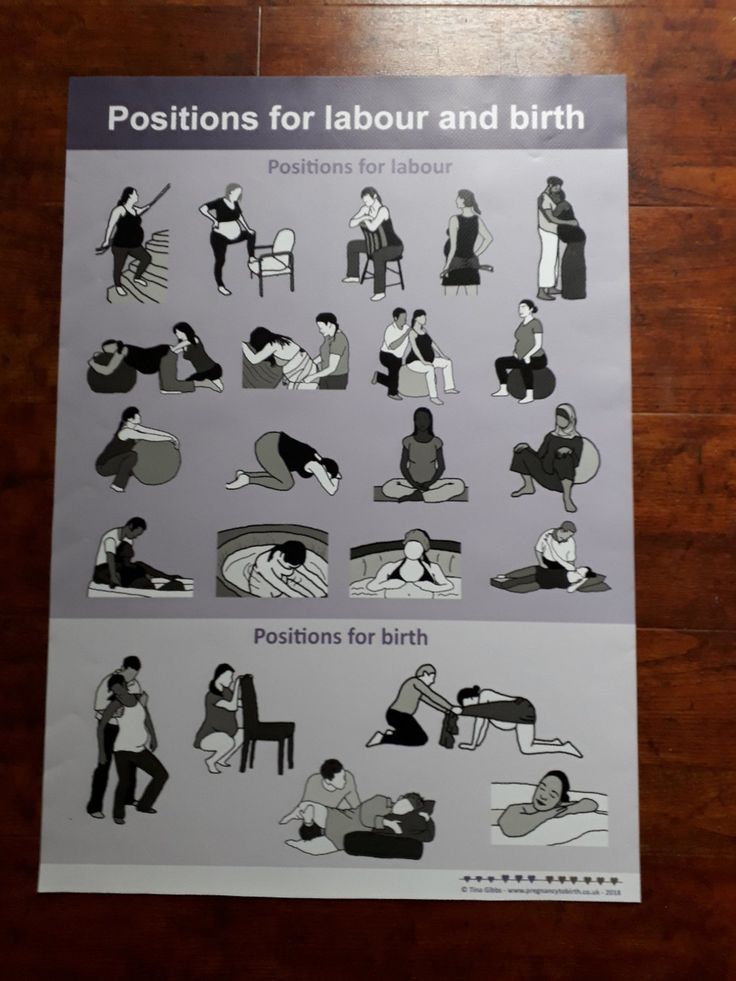
Positions for stage 2 labour
The second stage is when your cervix is fully dilated and as your contractions happen, you'll push so your baby can move through and out of your vagina.
Maintaining an upright position can open your pelvis and make it more comfortable for you to push. It can also help angle or tilt the pelvis to help the baby come down and lead to a faster birth.
If you are in bed, you can still kneel or go on all fours. You can also sit, semi-recumbent, on the bed, or lie on your side with your top leg bent.
If your baby is positioned facing your back (posterior) or halfway between your back or front (lateral), being on your hands and knees can help, particularly with back pain.
What could stop me moving or choosing my own positions?
- An epidural usually makes your legs feel heavy and numb so you will need to lie on the bed. However, new mobile, or 'walking', epidurals are now available to allow you to get up and move. You will need to check whether your hospital provides this.
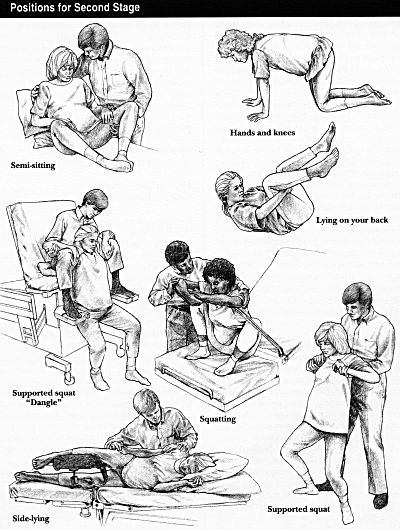
- An electronic monitor may be placed around your abdomen to check the baby's heartbeat and this may restrict your movement. Ask if your birthing facility has a mobile monitor, which will let you move around.
- If forceps or a ventouse (vacuum) is used to help your baby out of your vagina, you will need to lie on your back. The same applies for a vaginal examination or episiotomy.
How to practise using positions for labour and birth
- Join an antenatal class.
- Search for images and videos on the internet and practise at home.
Sources:
The Royal Australian and New Zealand College of Obstetricians and Gynaecologists (Provision of routine intrapartum care in the absence of pregnancy complications), Royal Australian and New Zealand College of Obstetricians and Gynaecologists (Labour and birth), The Royal Australian and New Zealand College of Obstetricians and Gynaecologists (Warm water immersion during labour and birth), Cochrane (Hands and knees posture in late pregnancy or labour), Cochrane Library Database of Systematic Review (Position for women during second stage of labour for women with epidural anaesthesia), Women and birth (What are the facilitators, inhibitors, and implications of birth positioning?), World Health Organization (WHO recommendation on birth position (for women without epidural analgesia))Learn more here about the development and quality assurance of healthdirect content.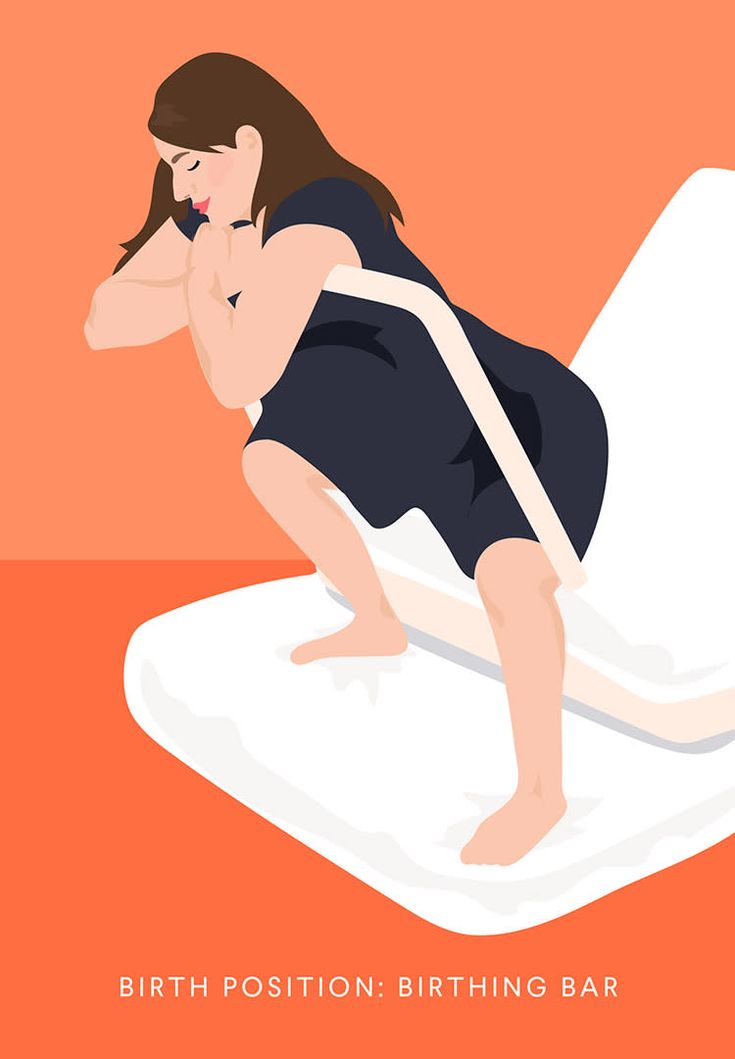
Last reviewed: February 2020
Back To Top
Related pages
- What to take to hospital - checklist
- Making a birth plan
- Choosing where to give birth
- Anatomy of pregnancy and birth
Need more information?
Anatomy of pregnancy and birth - pelvis
The pelvis helps carry your growing baby and is especially tailored for vaginal births. Learn more about the structure and function of the female pelvis.
Read more on Pregnancy, Birth & Baby website
Giving birth - first stage of labour
Find out what happens during the first stage of labour.
Read more on Pregnancy, Birth & Baby website
Labour and Birth
Read more on RANZCOG - Royal Australian and New Zealand College of Obstetricians and Gynaecologists website
Making a birth plan
Many expectant parents develop a written plan covering what they would like to happen during labour and birth.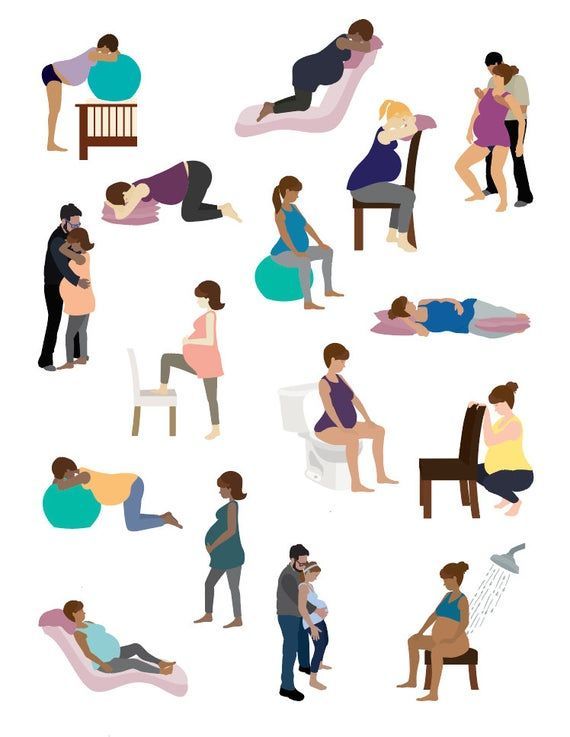 Know what to include if you create your own plan.
Know what to include if you create your own plan.
Read more on Pregnancy, Birth & Baby website
Developing a birth plan - Better Health Channel
A birth plan is a written summary of your preferences for when you are in labour and giving birth.
Read more on Better Health Channel website
Labour and birth classes
Labour and birthing classes (also called antenatal classes) will help you prepare for the birth of your baby. Learn here about the different classes available.
Read more on Pregnancy, Birth & Baby website
Having a baby at a birthing centre
Birthing centres are usually more home-like than hospitals and are run by midwives.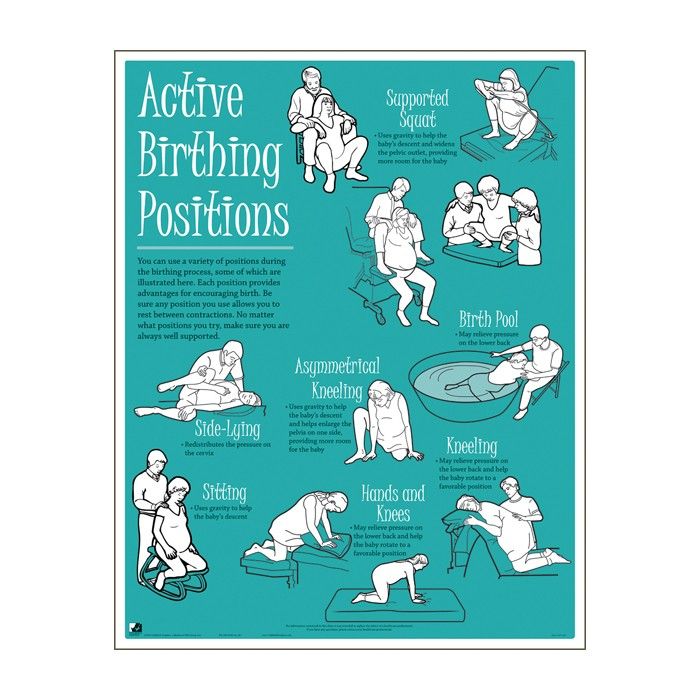 In some centres, water birth is an option.
In some centres, water birth is an option.
Read more on Pregnancy, Birth & Baby website
Pregnancy care & birth at birth centres | Raising Children Network
Birth centres support healthy women with low-risk pregnancies to give birth in a home-like environment. Pregnancy care at birth centres is led by midwives.
Read more on raisingchildren.net.au website
Going to hospital or birthing centre
Whether you're planning to have your baby at home, in hospital or at a midwifery-led birth centre, you should get a few things ready at least two weeks before your due date.
Read more on Pregnancy, Birth & Baby website
VBAC: vaginal birth after caesarean | Raising Children Network
For many women, vaginal birth after caesarean – VBAC – is a safe and positive way to have a baby.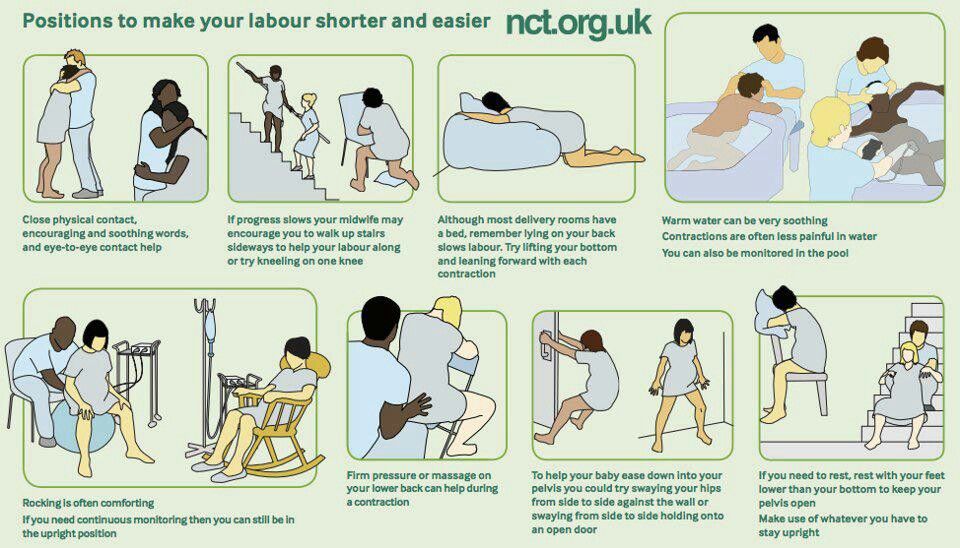 Our guide explains VBAC’s possible benefits and risks.
Our guide explains VBAC’s possible benefits and risks.
Read more on raisingchildren.net.au website
Disclaimer
Pregnancy, Birth and Baby is not responsible for the content and advertising on the external website you are now entering.
OKNeed further advice or guidance from our maternal child health nurses?
1800 882 436
Video call
- Contact us
- About us
- A-Z topics
- Symptom Checker
- Service Finder
- Linking to us
- Information partners
- Terms of use
- Privacy
Pregnancy, Birth and Baby is funded by the Australian Government and operated by Healthdirect Australia.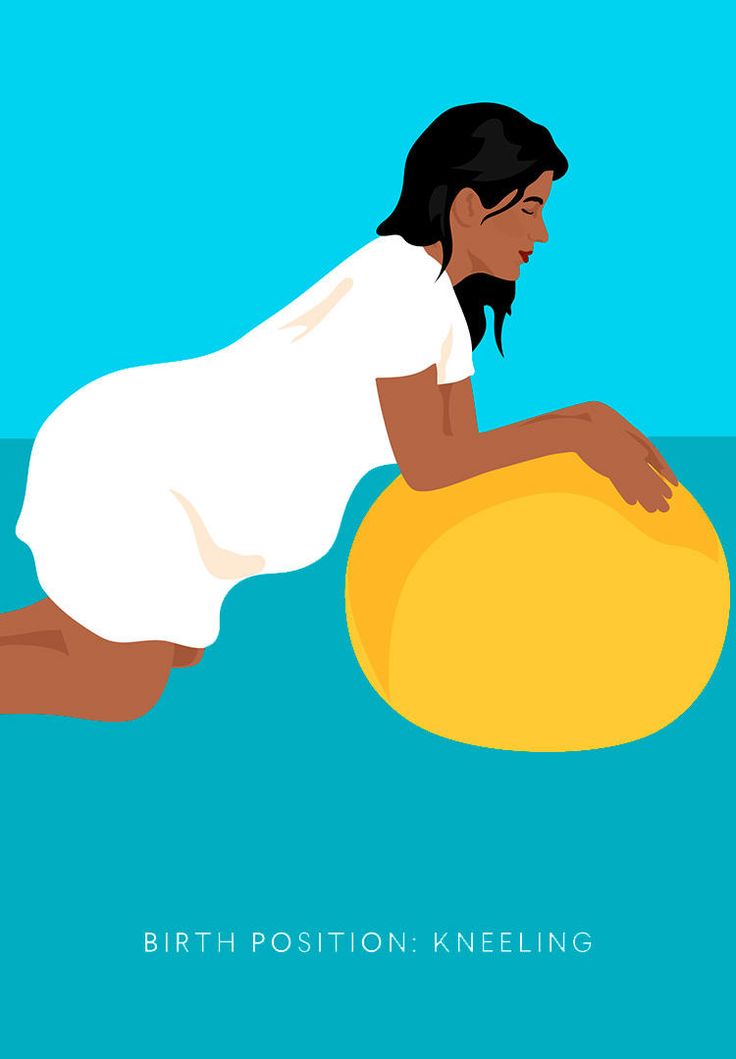
Pregnancy, Birth and Baby is provided on behalf of the Department of Health
Pregnancy, Birth and Baby’s information and advice are developed and managed within a rigorous clinical governance framework. This website is certified by the Health On The Net (HON) foundation, the standard for trustworthy health information.
This site is protected by reCAPTCHA and the Google Privacy Policy and Terms of Service apply.
This information is for your general information and use only and is not intended to be used as medical advice and should not be used to diagnose, treat, cure or prevent any medical condition, nor should it be used for therapeutic purposes.
The information is not a substitute for independent professional advice and should not be used as an alternative to professional health care. If you have a particular medical problem, please consult a healthcare professional.
Except as permitted under the Copyright Act 1968, this publication or any part of it may not be reproduced, altered, adapted, stored and/or distributed in any form or by any means without the prior written permission of Healthdirect Australia.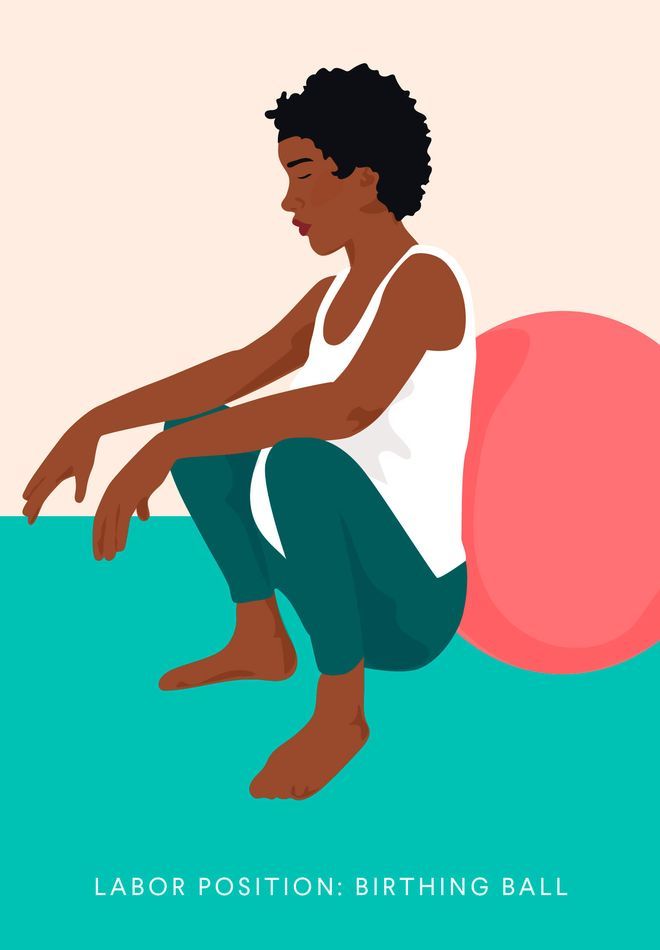
Support this browser is being discontinued for Pregnancy, Birth and Baby
Support for this browser is being discontinued for this site
- Internet Explorer 11 and lower
We currently support Microsoft Edge, Chrome, Firefox and Safari. For more information, please visit the links below:
- Chrome by Google
- Firefox by Mozilla
- Microsoft Edge
- Safari by Apple
You are welcome to continue browsing this site with this browser. Some features, tools or interaction may not work correctly.
Birthing positions that are safe for you and your baby
Finding the most comfortable position for you during childbirth is very important. This will make it easier for both you and your baby. If you choose the right position for you, your baby will be born faster, and the birth itself will be much easier. To do this, it is enough to correctly respond to the movements of the baby, who is trying to pass through the birth canal.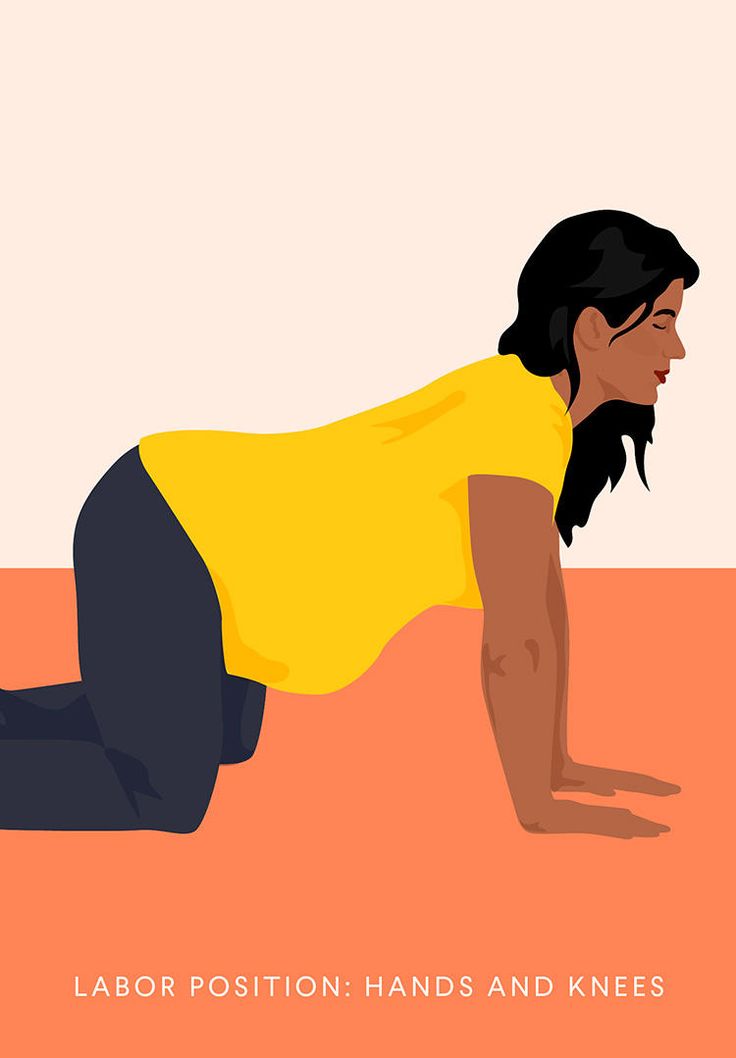
During the first stage of labor (dilatation), you can stand, bend over, kneel, walk, or sit. The baby moves through the birth canal with the help of uterine contractions. Due to gravity, his head presses on the cervix more and more, and it opens faster. Therefore, at this stage it is very important to move.
Use all the help available to you: a fitball, a ladder, a low chair, a window sill or a mattress, not to mention the help of your partner. Try different positions until you find the most comfortable position that will make it easier for the baby to pass through the birth canal.
In some maternity hospitals, you can take a bath that relaxes the muscles, reduces the strength of contractions and accelerates the opening of the cervix.
During the first stage, you will certainly feel fear and anxiety. In this case, walk around the room or go out into the corridor. If walking is difficult, ask someone next to you for help or lie back in bed.
Movement and standing help to expand the pelvis so that the baby can settle down comfortably before being born.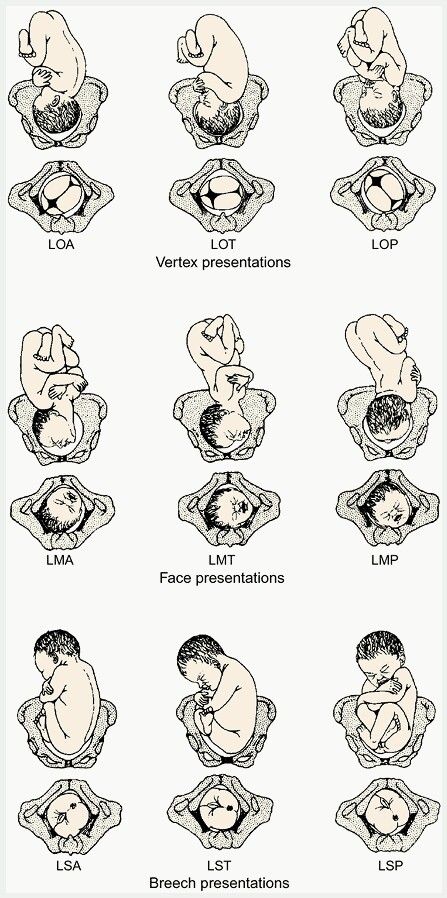
Standing with a partner
In this position, you stand with your legs apart. You lean on the escort's arms and lean forward slightly so that your stomach hangs down quietly. During contractions, you may shake your hips. Your partner can do the same movements. A slight forward lean will relieve your spine.
An escort may stand behind you and hold you under the armpits. In this case, you stand with your legs wide apart and your hands on your stomach.
This position may be uncomfortable for the midwife, who will have to sit on the floor to give birth. In addition, you may not be in full control of your contractions, and you may also experience severe pain in your legs. Therefore, when you use this pose, you need the help of an accompanying person.
Sitting on a fitball
This position is good in the early stages of labor when the baby's head is high. You sit on the ball with your legs wide apart, your feet resting on the floor. Place your hands on your knees or hold on to something for balance.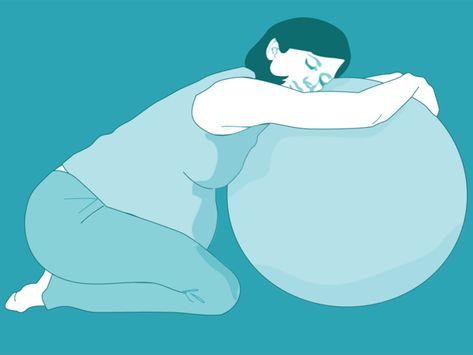 Rock your hips rhythmically in both directions.
Rock your hips rhythmically in both directions.
While sitting on the ball, you can jump slightly on it. Such movements relax the pelvic floor and help you breathe freely.
Leaning Forward on Your Knees
If you feel your contractions are not getting stronger, try the forward bending position, it will affect the strength and regularity of your contractions. This position with legs wide apart helps to correctly insert the baby's head at the exit from the small pelvis.
Get on one knee with a blanket or pillow underneath. Place your other foot on the floor. Shift your body weight onto that leg, moving rhythmically. Try to do this exercise during contractions while stretching your groin area. Don't forget about breathing. Inhale as you lean forward and exhale as you return to the starting position. Repeat several times on one knee.
Sitting on your heels
First kneel, and from this position, sit comfortably on your heels with your knees wide apart.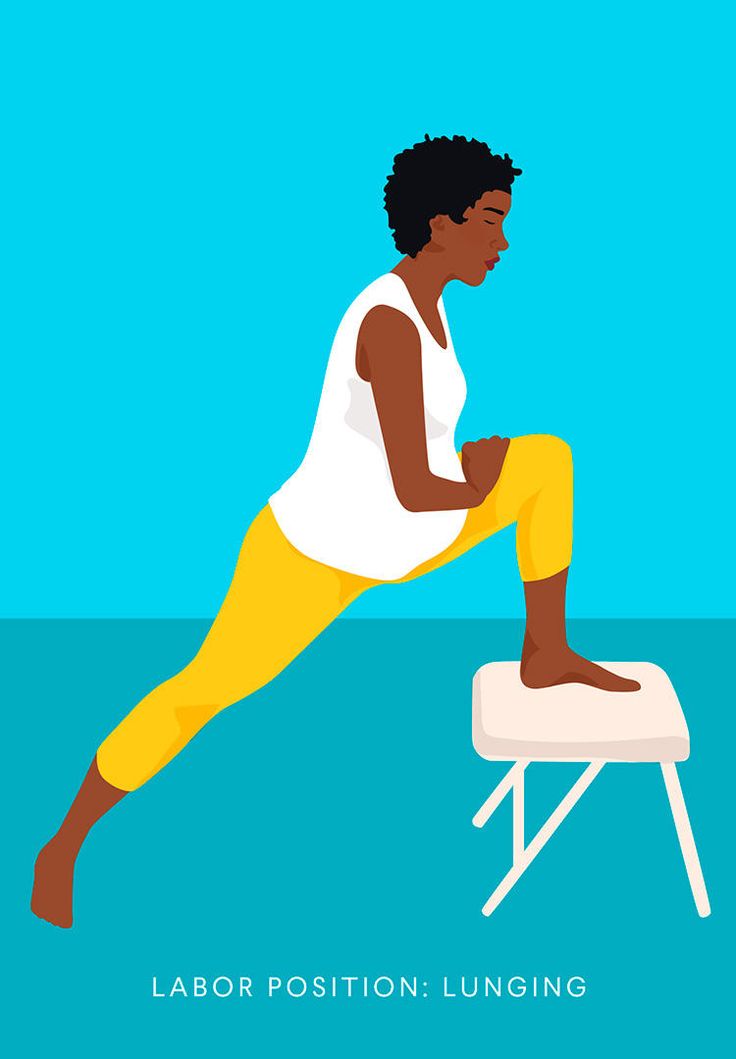 Straighten your arms and place them on the floor or on your hips with your fingers pointing inward.
Straighten your arms and place them on the floor or on your hips with your fingers pointing inward.
This position is suitable for strong contractions and when you have already successfully passed the first stage of labor. By leaning forward, you help the baby's head move quickly through the birth canal. Remember to breathe. To improve efficiency and reduce pain during contractions, you can rock back and forth.
Lying down
Lie comfortably on your left side. Place a pillow under your head and under your right knee. If you are more comfortable on the right side, then choose this position, but remember that it is the position on the left side that provides a full flow of blood to the placenta, which nourishes the baby.
In the supine position, the intensity of contractions weakens. You can use this time as a little respite. This is especially true during long fights, when a woman needs rest in order to gain strength before the next fight.
Kneeling with a ball
Try this pose if you feel pain in your lower back.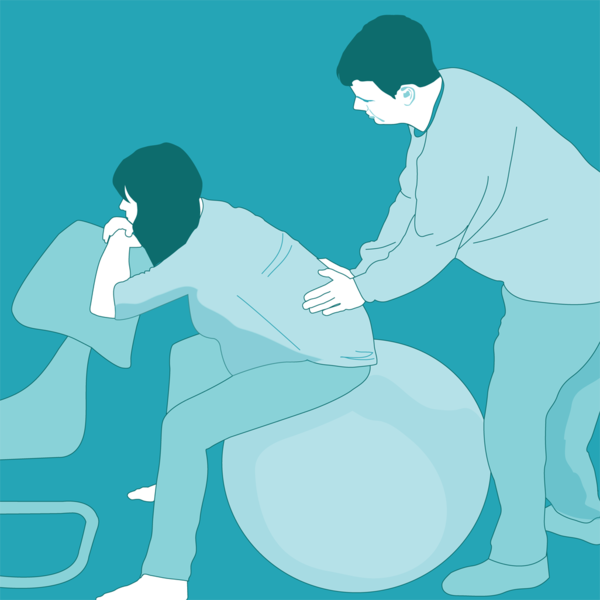 Get on all fours with your feet wide apart, or sit on your heels with your hands and head on the ball. During the fights, roll the ball back and forth. In this position, you gently press on the abdomen, causing stronger contractions, which causes the baby to move further and further down.
Get on all fours with your feet wide apart, or sit on your heels with your hands and head on the ball. During the fights, roll the ball back and forth. In this position, you gently press on the abdomen, causing stronger contractions, which causes the baby to move further and further down.
During the second stage of labor - the expulsion of the fetus - you must be active. Use the help of an attendant or hold on to the Swedish wall. Pushing in different positions helps intensify contractions.
On all fours
You will need the help of a guide in this position. This position is recommended for women with large children. It facilitates the opening of the cervix and reduces the pressure of the baby's head on the perineum, and also reduces the risk of perineal tears.
Kneel on a mattress or blanket with your feet wide apart. Place your arms and neck on your partner's arms.
Squatting
Squat down with your feet flat on the floor. Your legs should be wide apart.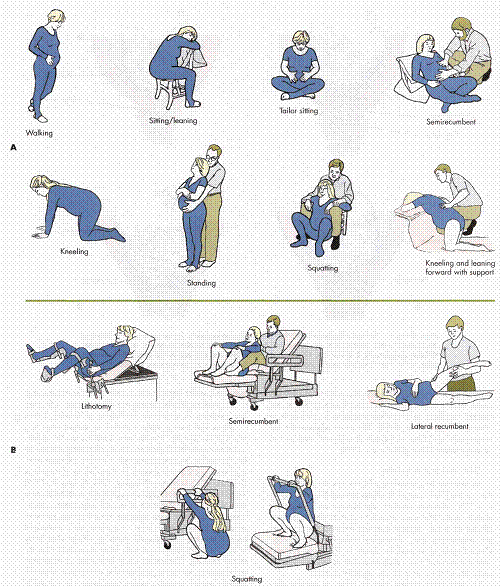 The accompanying person should sit on a high chair so that your buttocks do not touch the floor. During the fight, you lean on your partner's legs, and he can hold you under the armpits.
The accompanying person should sit on a high chair so that your buttocks do not touch the floor. During the fight, you lean on your partner's legs, and he can hold you under the armpits.
In this position, the baby moves faster through the birth canal, often without your efforts, but only thanks to the strength of the contractions.
Wall Squat
Squat with your feet flat on the floor with your legs slightly apart. To maintain balance, hold on to one of the bars of the Swedish wall with outstretched arms. In the same way, you can hold on to the bed frame or window sill. Stay in this position during contractions. Remember that you should get up after the fight to stretch your legs.
This position makes it much easier for the baby to move through the birth canal.
Lying on your side
Lie on the bed with your knees bent, choose whether you feel more comfortable lying on your left side or on your right side. Sometimes the obstetrician can advise you on a certain side, and this depends on the position of the baby in the mother's abdomen.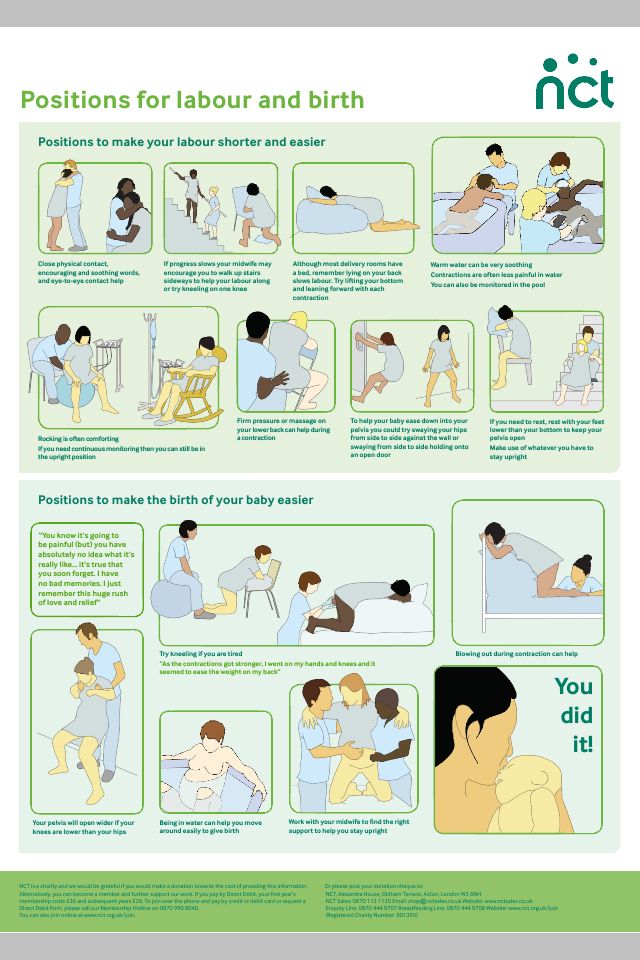 Place pillows under your head and body, or have the top of the bed raised. During contractions, try to curl up, pull one leg towards you and try to bring your head to your chest. This posture puts more pressure on the chart, making pushing more effective.
Place pillows under your head and body, or have the top of the bed raised. During contractions, try to curl up, pull one leg towards you and try to bring your head to your chest. This posture puts more pressure on the chart, making pushing more effective.
Half-sitting
Sit on the obstetric bed with your knees bent wide apart. During contractions, the companion tilts your head to your chest while you hold on to the rails of the bed and try your best to pull yourself up or stand up on your elbows. You can also put your feet on special stands or press them with both hands to yourself, bending at the knees.
This is a very comfortable position for the midwife, as it makes it easier for her to follow the birth process. However, this position is more painful for you, because the coccyx is heavily loaded.
During the breaks between contractions, you can ask your partner or obstetrician to massage the most painful and tight areas such as shoulders, lower back, face and legs.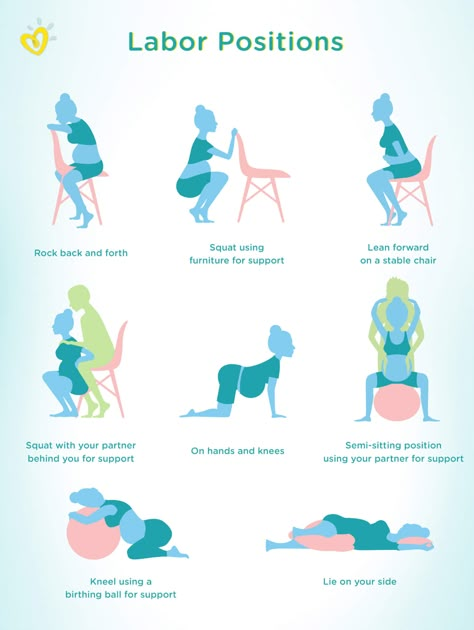
If this does not relieve you, but only irritates you, your partner may simply put his hands on the painful areas. These touches will also help you feel better. If you don't want anyone to touch you, just say so, you have every right to feel that way.
The midwife will definitely advise you on which position to choose and which position will be most comfortable. Your attitude towards the birth process and the desire to work together is very important. You all can! Women have a huge hidden potential, which they do not even know about, which allows them to endure the pain during childbirth. Remember this! Don't worry, be courageous and everything will be fine.
Postures of a woman during childbirth | Mamovedia
Most of the women who already have the experience of having a baby can say with confidence that, despite the fact that childbirth is a physiological process, it still requires some knowledge, effort and skills.
It is very important to know what positions a woman in labor can take during childbirth in order to facilitate the birth process.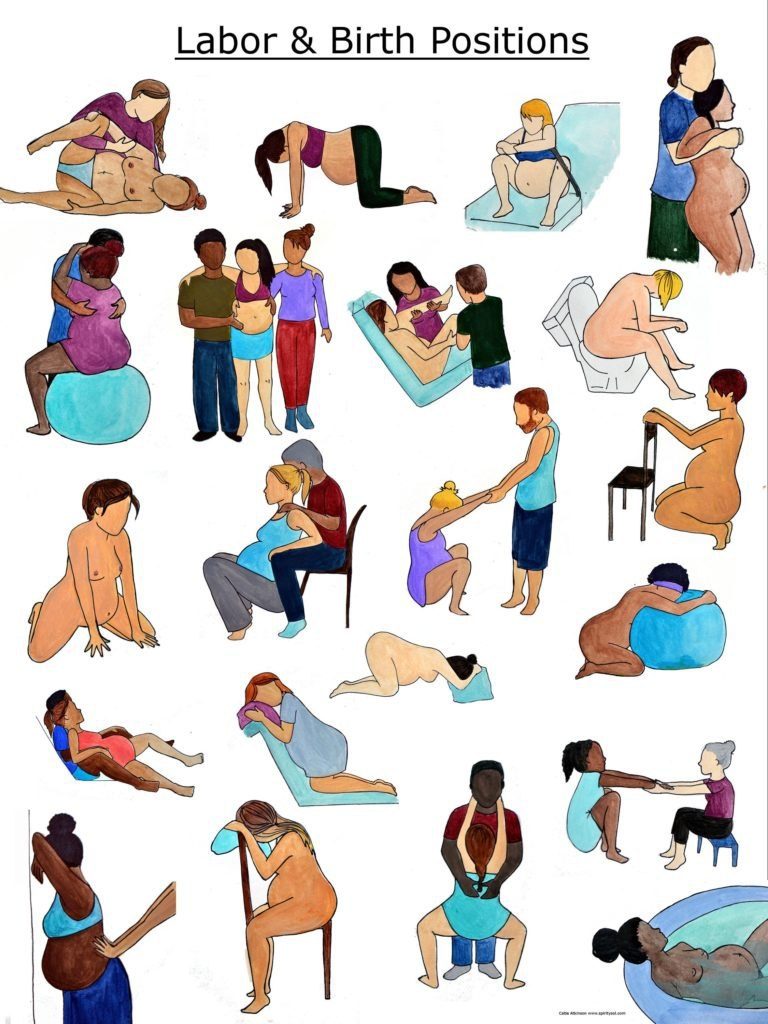 The importance of choosing the right position during childbirth is that if a woman is uncomfortable, she will quickly get tired and weaken. In no case should this be allowed, since an unborn baby may suffer from such a state of the future mother.
The importance of choosing the right position during childbirth is that if a woman is uncomfortable, she will quickly get tired and weaken. In no case should this be allowed, since an unborn baby may suffer from such a state of the future mother.
Many women rely on their intuition and internal sensations when choosing a position at one stage or another during childbirth. This is true, but at the same time it is necessary to have ideas about some other postures in order to take a different position of the body at the moment of need.
Since childbirth is not a situation where you can proceed by trial and error, it is best to familiarize yourself with the possible and recommended labor positions long before the onset of labor. If a woman has a clear idea of the possible set of positions during childbirth, then she will be able to choose the most convenient and comfortable from this arsenal, relying on her feelings and needs.
During the period of contractions, in the event that the woman in labor does not have any complications of labor, the doctor will allow you to behave freely.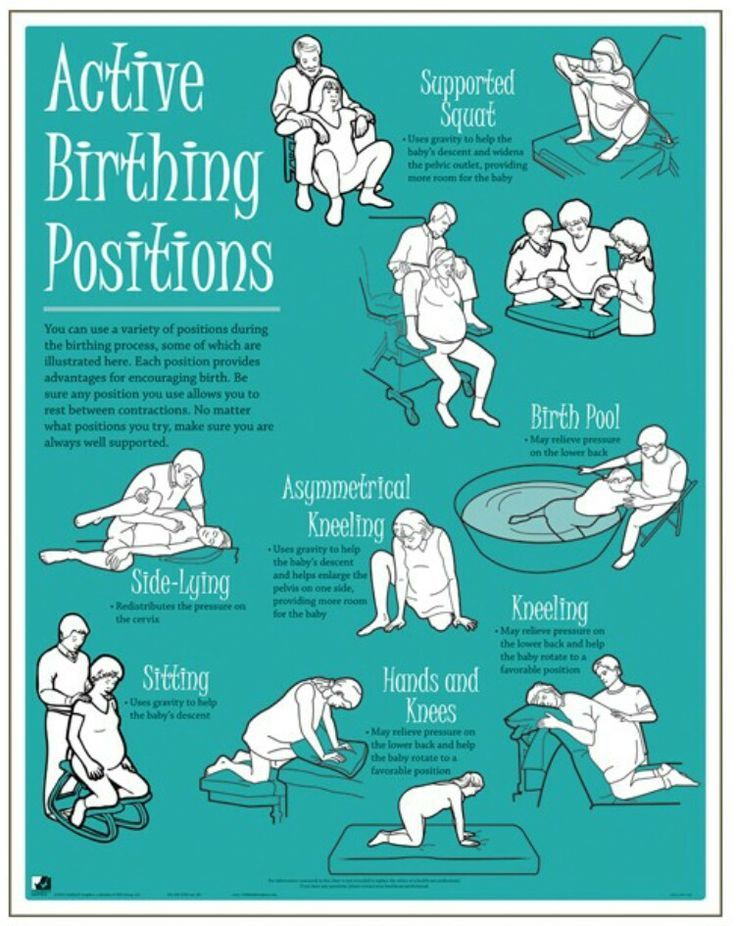 In this case, a woman can choose any position for herself in which she will feel comfortable and comfortable.
In this case, a woman can choose any position for herself in which she will feel comfortable and comfortable.
Everyone understands that the period of contractions is the most painful for a woman, so the main task of postures in childbirth is to alleviate the condition of the woman in labor. At the stage of contractions, a woman in labor can walk around the ward, sit on a fibol, or dive into the water. Some moms-to-be do best with contractions while standing in the shower.
Perfectly relieves pain during labor posture in which the woman in labor stands leaning on a chair, table or headboard, while her back and legs form an angle of 90 degrees. In this case, the weight of the body must be transferred to the hands.
In the event that during the contractions a woman has a strong back pull, then the cat pose is very suitable for her. In order to perform this pose, you need to get on all fours so that the stomach sags. At the same time, pain can be alleviated by rocking the hips and pelvis.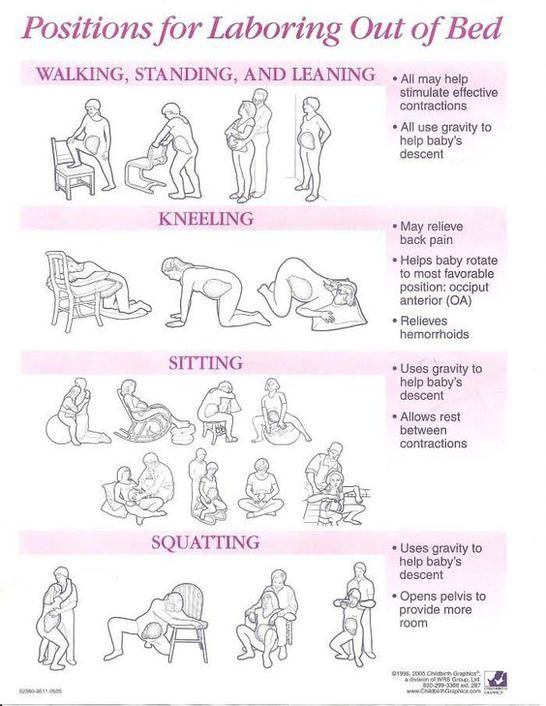 With the help of the cat pose, you can relax the muscles of the perineum and speed up the process of opening the cervix.
With the help of the cat pose, you can relax the muscles of the perineum and speed up the process of opening the cervix.
Some women who have been exercising during pregnancy find the lotus position very helpful. But this position is prohibited when the baby's head has already sunk to the pelvic floor.
When the baby is down, the woman can kneel and place a pillow under her breasts.
When the pushing period comes and it's time to push the baby out, many doctors advise to take the supine position. To date, it has been proven that this position is convenient only for doctors, but it is completely uncomfortable for a pregnant woman and her baby. The supine position can impair blood circulation to the placenta and cause dizziness.
It is recommended to give birth on the back if the pregnancy is premature, the baby may show signs of intrauterine retention, or in the case of a breech presentation.
The side-lying position with bent knees is similar to the end of the first stage of labor, when the cervix is fully opened.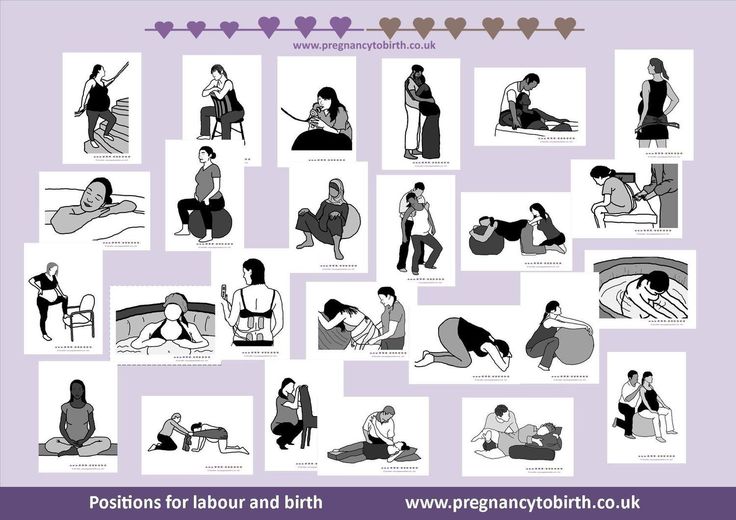 In this position, a woman can relax a little and gain strength before trying. The birth of a child in this position occurs by the fact that the mother raises the upper leg in a bent form or holds it with her hand.
In this position, a woman can relax a little and gain strength before trying. The birth of a child in this position occurs by the fact that the mother raises the upper leg in a bent form or holds it with her hand.
Very many women in childbirth are helped by the squatting position. To do this, you need to squat down, hugging your knees, spread your legs wide, and tilt your torso forward. When the baby's head erupts, the knees must be straightened so that the doctor can control the process. This position helps a woman in her attempts, while the baby will go out almost on her own.
In repeated births, when the woman's birth canal is already wide enough, the all-fours position may be appropriate. If at the same time the woman spreads her legs, then the baby is more likely to go down.
Whatever position you chose during childbirth, you must remember that it is very important to relax in any position.
For the pain relief of contractions, the most commonly used positions are those that have been tested by time, women in labor and obstetrician-gynecologists.